What We Fish
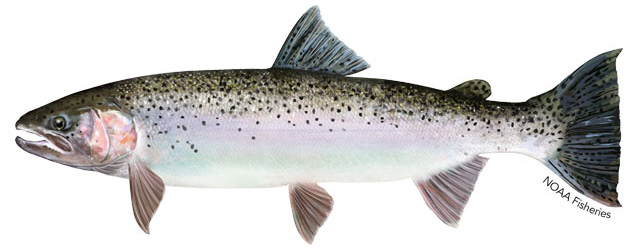
Steelhead Trout
Steelhead, the anadromous form of rainbow trout, are economically important as a commercial fishery and culturally important to Native American Tribes. Steelhead are one of the top five recreational fish species in North America. Steelhead have been known to jump 11ft (3.35 m) into the air when climbing falls on migration runs and can go from zero to 25 mph (40.2 kmsec) in one second! The offspring of two steelhead parents may become a purely fresh water form of rainbow trout and the offspring of two freshwater resident forms of rainbow trout might evolve into the anadromous form of rainbow trout called “steelhead”. The oldest steelhead ever captured was 11 years of age. Steelhead that migrate to the ocean develop a slimmer profile, become more silvery in color, and typically grow much larger than the rainbow trout that remain in fresh water. Rainbow trout can normally weigh between 8 – 11 lbs. (3.6 – 5 kg). There have been reports of steelhead weighing up to 55 lbs. (25 kg).
SIZE: Steelhead normally reach lengths of 24 in (61 cm) but have been reported reaching lengths of 45 in (120 cm).
RANGE: Historically, rainbow trout or steelhead are native to North America, west of the Rocky Mountains.
HABITAT: Depending on what phase of their life history strategy they are in, steelhead live in freshwater rivers and streams, estuaries and marine environments. Steelhead occupy freshwater streams or lakes during spawning and then migrate back through brackish water to the open ocean to live during their adult non-spawning phase of their life cycle. Steelhead spend most of the year in estuaries or open ocean and only return to fresh water to spawn.
DIET: Steelhead feed on a variety of aquatic and terrestrial invertebrates and small fish. They normally feed on zooplankton when they are young and as they mature begin to include fish eggs, crustaceans, mollusks, small fish and even mice in their diet.
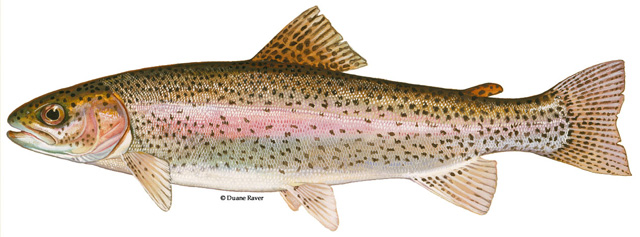
Rainbow Trout
Adult freshwater stream rainbow trout average between 1 and 5 lb (0.5 and 2.3 kg), while lake-dwelling and anadromous forms may reach 20 lb (9 kg). Coloration varies widely based on subspecies, forms and habitat. Adult fish are distinguished by a broad reddish stripe along the lateral line, from gills to the tail, which is most vivid in breeding males.
Wild-caught and hatchery-reared forms of this species have been transplanted and introduced for food or sport in at least 45 countries and every continent except Antarctica.
Freshwater resident rainbow trout usually inhabit and spawn in small to moderately large, well oxygenated, shallow rivers with gravel bottoms. They are native to the alluvial or freestone streams that are typical tributaries of the Pacific basin, but introduced rainbow trout have established wild, self-sustaining populations in other river types such as bedrock and spring creeks. Lake resident rainbow trout are usually found in moderately deep, cool lakes with adequate shallows and vegetation to support production of sufficient food sources. Lake populations generally require access to gravelly bottomed streams to be self-sustaining
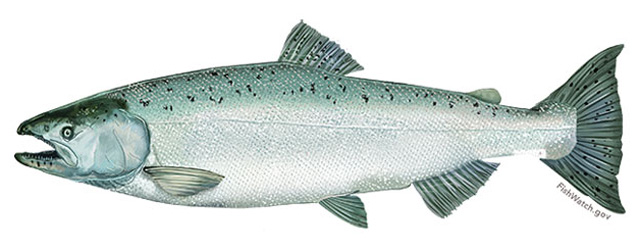
Chinook Salmon
Some populations of Chinook salmon migrate more than 2,000 miles to spawn in in the upper Yukon River to spawn. Specimens of Chinook salmon have been recorded to weigh as much as 135 lbs. (61.4 kg.) Maximum reported age for Chinook salmon is 9 years.
SIZE: The average weight for chinook salmon is around 40 lbs. or 18 kg. The common length for chinook salmon is 70 cm (27.6 inches) with the maximum recorded length for Chinook salmon being 159 cm (50 inches).
RANGE: The range of Chinook salmon extends from the Arctic, northwest to northern Pacific: drainages from Point Hope, Alaska down to Ventura River, California. They are also found in Honshu Japan, the Sea of Japan, the Bering Sea and the Sea of Okhotsk.
HABITAT: Chinook salmon are an anadromous species that spend their adult life in salt water and then migrate into their freshwater natal streams to spawn.
DIET: During their adult life history stage, Chinook feed on squid and fish such as the sandlance and herring. In the juvenile stages, Chinook feed on terrestrial insects and small crustaceans.
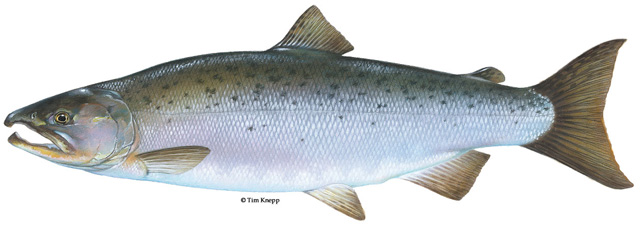
Coho Salmon
Coho salmon average 8 lbs. or 3.6 kg but may weigh as much as 35 lbs. or 16 kg. The life span of Pacific coho is variable. The oldest recorded age for coho salmon is 5 years. These fish occur in the ocean or in lakes. Young fish migrate at night into lakes or the ocean. Fish that remain in freshwater for more than two years and reach sexual maturity are called “residuals” and never spawn.
SIZE: Coho salmon average 24 inches (9.4 cm) long, but specimens have been recorded as long as 42.5 inches (108 cm).
RANGE: Coho salmon in the North Pacific range from the Anadyr River in Russia, southward towards Hokkaido, Japan. Coho range from Point Hope in Alaska, southward to Chamalu Bay in Baja California and all the way into Mexico.
HABITAT: Coho salmon are an anadromous species that primarily spend their adult life in salt water and then migrate into freshwater to spawn. The exceptions to this strategy include the residuals that are described in the above paragraph. In general, adult coho salmon migrate from the sea or lake, then school at the river mouths and proceed upstream when precipitation significantly increase water flows. Upon arriving at spawning areas, which are normally small tributaries with stable gravel substrates, the female will find a spot and dig a pit with her tail. While preparing the spawning pit, the female is accompanied by a male that wards off other male coho salmon that swim near the pit. Upon completing the pit, the female coho salmon drops into the pit to first deposit the eggs and then the male coho salmon will follow the female and fertilize the eggs with his milt.
DIET: Young coho salmon which inhabit lakes and rivers eat mainly insects. When migrating to the sea, the young salmon dine on planktonic crustaceans. As they grow and move further out to sea, they begin to hunt larger forage species such as fish, squid and jellyfish.
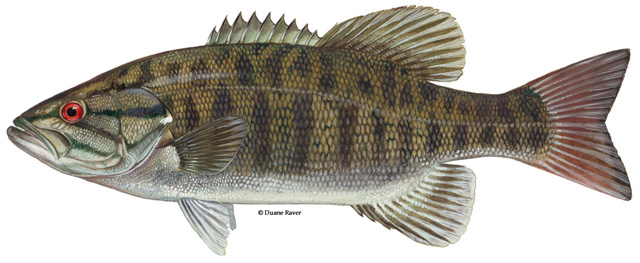
Smallmouth Bass
It normally takes three to five years of growth before smallmouth bass are legally harvestable in states that have a minimum recreational size limit of 12 inches. The oldest reported age for smallmouth bass is 26 years. The heaviest reported weight for a smallmouth bass is 5.4 kg (11 lbs., 15 oz.)
SIZE: The length of smallmouth bass most commonly caught is between 12 and 16 in (30.5 cm to 40.6 cm). The maximum recorded length for a smallmouth bass is 27.2 in (69 cm). Generally, male smallmouth bass are smaller than female smallmouth bass.
RANGE: The range of smallmouth bass in North America includes the St. Lawrence Seaway to the Great Lakes systems and Hudson Bay. Their range extends from southern Quebec in Canada to North Dakota and south to northern Alabama and eastern Oklahoma within the U.S. They are also present in the drainages of the Mississippi river basins. Smallmouth bass have also been introduced into England, Europe, Japan, Russia and into Africa.
HABITAT: Adult smallmouth bass live in shallow rocky areas of lakes and in the clear and gravel bottom runs and flowing pools of rivers. They also live in cool flowing streams and reservoirs fed by these types of streams.
DIET: Young smallmouth bass feed on plankton and immature aquatic insects. Smallmouth bass are also known to be cannibalistic. Adult smallmouth bass may feed on crayfish, fish and aquatic and terrestrial insects.
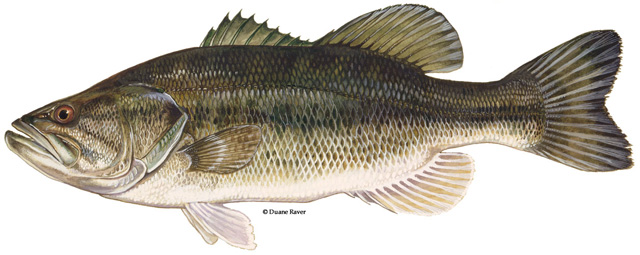
Largemouth Bass
Recreational sport fishing for largemouth bass has become extremely popular in the United States. This sport is now a multi-billion dollar industry. Largemouth Bass fishing has significantly expanded from its humble beginnings in the late 19th century. This new industry is now driving the development of new types of fishing gear specifically designed for catching largemouth bass, electronic “depth” finder and “fish” finding instruments, drift boats, float tubes and specialized bass boats. Largemouth bass have been introduced widely as a recreational fish species throughout the world. As a result, competitive bass fishing has now spread to the countries of Japan, Korea, Italy, Australia and South Africa. Some countries have reported negative impacts resulting from the introduction of largemouth bass in non-native waters. The maximum reported age for largemouth bass is 23 years. The heaviest reported weight for was 10.1 kg (22 lbs.)
SIZE: Common length for largemouth bass is 40 cm (15.7 inches) with the longest recorded specimen being 97 cm (38.2 inches).
RANGE: The range of largemouth bass within North America extends from the St. Lawrence River, the Great Lakes, Hudson Bay (Red River) and into the Mississippi River basin. Largemouth bass are also found in Atlantic drainages from North Carolina to Florida and into northern Mexico.
HABITAT: Largemouth bass inhabit clear, vegetated lakes, ponds, swamps, and the backwaters of pools, creeks and rivers. Largemouth bass prefer spawning areas with a firm bottom of sand, mud or gravel. Adult largemouth bass utilize submerged aquatic vegetation as cover to ambush prey and juvenile or young largemouth use aquatic weeds, tree limbs or submerged log or stumps as cover to escape predation. Dissolved oxygen is also an important hydrological condition essential to largemouth bass habitat.
DIET: Adult largemouth bass feed on fish, crayfish and frogs. Young largemouth bass will feed on crustaceans, insects, and small fish. Some largemouth bass can be cannibalistic just like northern pike. Largemouth bass normally do not feed during spawning or when the water temperature dips below 5 degrees Celsius (41 degrees Fahrenheit) or above 37 degrees Celsius (98.6 degrees Fahrenheit).

